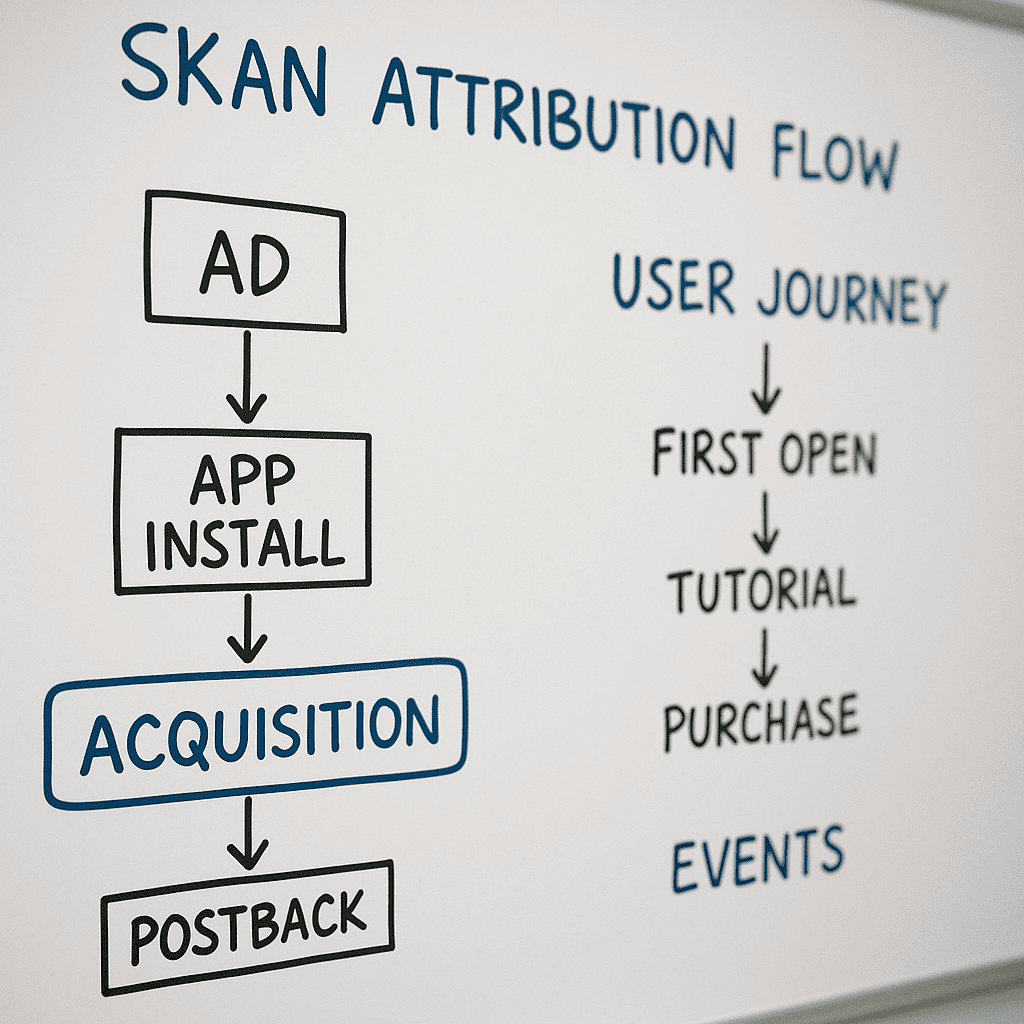
Scaling User Acquisition in the Era of Apple’s SKAN
User acquisition is the engine that powers mobile app growth, yet recent privacy measures have disrupted traditional measurement models. Apple’s SKAdNetwork (SKAN)—soon evolving into AdAttributionKit—now dictates how marketers attribute installs, optimize campaigns, and scale effectively. In this article, we demystify SKAN’s latest updates, unpack core acquisition tactics, and provide actionable guidance for growth teams navigating a privacy-first landscape.
The Evolving Attribution Landscape on iOS
Since its launch in 2018, SKAdNetwork has undergone multiple version upgrades to balance user privacy with advertiser performance insights. With Apple’s announcement of AdAttributionKit in early 2025, marketers face a multi-phase transition:
- SKAN v1–3 (Current): Offers basic postback data and single conversion value reporting.
- SKAN v4.x (Rolling Out): Introduces multiple conversion windows, coarse-grained source IDs, and hierarchy-based value mappings.
- AdAttributionKit (Future): Expands customization, deeper event reporting, and advanced privacy thresholds.
Understanding this roadmap is crucial: each version shift demands updated measurement setups and new optimization workflows.
Core Strategies for Scaling User Acquisition
Growth leaders must blend organic and paid tactics, leverage data-driven insights, and optimize every touchpoint. Below are five proven channels and approaches:
App Store Optimization (ASO)
ASO remains the bedrock of organic discovery. Focus on:
- Keyword Research: Identify high-volume, niche terms with moderate competition.
- Visual Assets: Use localized screenshots and short demo videos to boost conversions.
- Review Velocity: Prompt engaged users to rate your app post-key milestones.
Brands that regularly A/B test store creatives see up to 30% uplift in organic installs.
Paid Channels
Diversify ad spend across platforms to reach distinct audience segments:
- Apple Search Ads: Leverage broad match and exact match campaigns for discovery keywords.
- Social & Video Ads: Test dynamic creatives on Facebook, TikTok, and YouTube.
- Programmatic Networks: Use contextual targeting and SDK-less bidding to minimize data leakage.
Consistent creative rotation and channel-level attribution benchmarking keep CPI efficient and scalable.
Product-Led Growth
Embed growth loops within the app itself:
- Referral Incentives: Reward existing users for inviting peers.
- Freemium Upsells: Offer tiered access to premium features.
- In-App Review Prompts: Trigger at positive engagement moments to boost rating volume.
Apps with built-in referral mechanics often see 20–50% of installs originate from existing users.
Retargeting & User Engagement
Re-engage inactive cohorts to increase lifetime value:
- Personalized Push Campaigns: Segment by in-app behavior and send tailored offers.
- Email Drip Flows: Automate sequences that highlight key features for dormant users.
- Dynamic Ads: Serve context-aware creatives on Meta and Google Display Network.
Cross-Promotion & Omni-Channel
Leverage all touchpoints to drive mobile installs:
- Web-to-App Banners: Embed interstitials on high-traffic pages.
- Email Signatures: Include app links in corporate communications.
- QR Codes: Use in offline campaigns and events.
Navigating Apple’s SKAN: Key Updates Marketers Must Know
Apple’s privacy-first stance demands a shift from device-level tracking to aggregate and cohort insights. Below are the critical SKAN changes impacting UA teams:
Unified Attribution Across Channels
Apple Search Ads now reports installs via both SKAdNetwork and the AdServices API, enabling side-by-side performance comparisons. However, this dual reporting is limited to click-through attributions—view-through remains unsupported.
Click-Through Only Attribution
SKAN v4 enforces click-only attribution windows for ASA placements (Search Results, Today Tab, Product Page). This restriction requires tighter attribution logic and faster optimization cycles.
Dual Reporting via SKAN and AdServices API
Marketers receive:
- SKAN Postbacks: Privacy-safe, delayed insights with conversion value.
- AdServices Reports: Real-time installs and keyword performance for Apple Search Ads.
Combining both views gives a holistic picture while honoring user anonymity.
Regulatory Drivers & Future Roadmap
Apple’s integration of ASA into SKAN was partly driven by antitrust scrutiny. Looking ahead, AdAttributionKit will unlock:
- Multi-event reporting beyond a single conversion value.
- Adjustable privacy thresholds based on campaign volume.
- Enhanced source identifiers for improved channel differentiation.
Optimizing for SKAN: Practical Tactics
To thrive under SKAN’s privacy constraints, adopt these best practices:
Cohort Analysis & Aggregate Data
Move from user-level to cohort-level tracking:
- Group installs by campaign, geo, and creative set.
- Analyze retention and revenue curves over 24-, 48-, and 72-hour windows.
- Use probabilistic modelling to infer performance trends.
Conversion Value Configuration
Design a value schema that captures your most meaningful events:
- Map high-value actions (e.g., purchases, subscriptions) to the upper range of SKAN’s 6-bit value field.
- Use multi-tiered bucketing to track early engagement (onboarding, tutorial completion).
- Regularly recalibrate buckets based on lifecycle shifts.
Short Attribution Windows & Timing
SKAN’s 24- to 72-hour attribution windows demand rapid user activation:
- Prioritize onboarding flows that drive first-day engagement.
- Implement real-time prompts (push, in-app messaging) within the first hour.
- Monitor postback trends daily to adjust bids and budgets.
Creative Experimentation & Broad Segmentation
Without granular user data, creative strategy becomes paramount:
- Test messaging frameworks (problem/solution, social proof, emotional triggers).
- Rotate assets every 7–10 days to prevent ad fatigue.
- Use broad audience segments and let SKAN’s thresholds optimize delivery.
Partnering with SKAN Experts
Working with agencies specialized in privacy-first measurement can accelerate your learning curve. Admiral Media offers tailored SKAN audits, technical integrations, and ongoing optimization support to maximize ROI.
Measuring Success in a Privacy-First World
Redefine KPIs and leverage the right tools:
- Day 1–3 Retention Rates: Track short-term stickiness to assess onboarding efficacy.
- Revenue per Install (RPI): Use cohort-level LTV curves instead of single-user ARPU.
- Cost per Loyal User (CPLU): Calculate CPI divided by the percentage of users meeting your retention threshold.
Integrate dashboards that pull SKAN postbacks, ASA AdServices data, and server-side events for a unified view. Regularly review performance in weekly growth huddles and adjust creative, bidding, and budget allocations based on cohort signals.
Conclusion & Next Steps
The shift to Apple’s privacy-centric attribution framework is more than a technical upgrade—it reshapes how growth teams plan, measure, and optimize user acquisition. By blending proven UA channels with SKAN-optimized tactics, marketers can sustain scalable growth in a world where user privacy is paramount.
Ready to adapt? Audit your current measurement setup, recalibrate conversion values, and partner with experts to ensure you’re primed for the AdAttributionKit era.
Learn more about advanced user acquisition and privacy-first attribution at Admiral Media.
